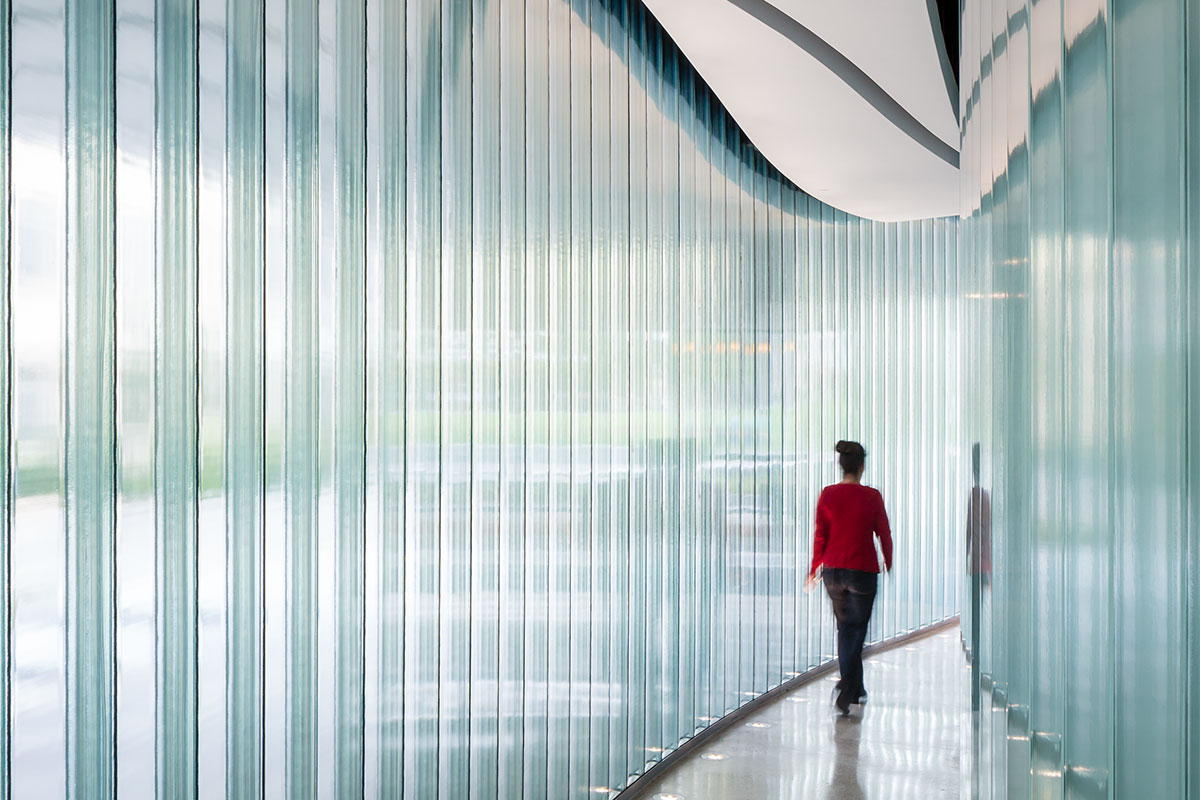Deep Diving into Channel Glass
David Vermeulen, North America Sales Director, Technical Glass Products

When people think of architectural glass, most probably imagine flat panels installed as windows, doors or curtain walls. But there’s another option. Less common, channel glass can offer a high-performance alternative that gives an extraordinary visual impact to curtain walls and storefront assemblies.
For example, the Emerald condominium’s exterior channel glass assemblies diffuse the sun's rays to create soft, glare-free light. The Pilkington Profilit™ channel glass system also helps “reinforce the unique nature of the faceted tower.”
While The Emerald’s designers wanted a unique interior atmosphere for the building’s occupants, the designers of the Center Steps Apartments used Pilkington Profilit™ channel glass to create ambiance for those passing by. The system is backlit with LED lighting for a soft but palpable glow—inviting pedestrians to linger in the communal outdoor spaces around the building.
As these projects show, channel glass can support a range of aesthetic considerations, helping designers create visually stunning architectural features. Because of its structural stability and capacity to be used across large spans without the need for vertical mullions, channel glass is a versatile architectural product. Despite its benefits, channel glass remains a mystery to some. The following deep dive explains what this product is and how it can help enhance a building’s design.
What is channel glass?
For over 40 years, channel glass has helped designers build stunning façades, storefronts and interior walls.
Cast in a U-shape, channel glass is self-supporting and held in place by an extruded aluminum perimeter frame. Its flange depth is standardized to be approximately 2.36 inches (increasing to 2.64 inches when channels are nested together as a “dual glazed” product) and is available in widths from around nine inches to 13 inches.
Whether used as an interior or exterior wall, channel glass can be configured in a variety of ways to achieve designs that are beyond the capabilities of conventional flat glass—from standard vertical or horizontal installation to curved or even raked heads and sills. Because its U-shape allows it to span up to 23 feet, channel glass can facilitate large segments of uninterrupted glass.
Extending its utility, channel glass can be specified in several levels of opacity. This allows architects to dial in the exact balance of daylight access and privacy afforded to their projects.
Channel glass creates high visual impact
Channel glass’ wide range of textures and colors can contribute to the goals of almost any design aesthetic. For instance, Pilkington Profilit™ OW (Low-Iron) has a low iron content that allows for greater light and solar transmission. Several studies have indicated that access to natural light can elevate mood and support occupant psychological well-being, so designers can use channel glass to maximize daylight access to support the building’s end-user.
For applications that need glare-free light, like libraries and offices, architects can use sandblasted channel glass to incorporate pleasant, diffused natural light without the visual obstruction that unfiltered sunlight can sometimes present. The product’s ability to allow soft light to flow throughout a space can also help regulate building occupant’s circadian rhythms.
Additionally, architects around the world have specified channel glass for art galleries and museums since its textures and waves disperse sunlight for a softer illumination. Further, because it does not need vertical mullions, channel glass casts no shadow, allowing the artwork within a museum to be viewed without obfuscation.
Channel glass can also be sandblasted for improved privacy that also allows light transmission. This option is perfect for bathrooms, office lounges, healthcare settings and anywhere that requires privacy but would be improved with access to daylight.
These opacity options can be used in horizontal, vertical or curved applications. Because the product can create expansive areas of uninterrupted glass and the striking lines from the repetition of channels, it contributes to a contemporary feel. Whether used in single-story applications or across multiple floors, channel glass can elevate the look and feel of a building in a cost-effective manner.
Meeting performance criteria with channel glass
In addition to its aesthetic versatility, channel glass offers many structural benefits. Able to span lengths beyond wind load limitations, this product can help create striking monolithic exterior glass walls. It also helps insulate a building’s interior.
With R-values that are considerably higher than regular glass, architects can use channel glass to achieve more stable temperatures inside a building, which can lead to increased energy savings. When channels are nested together, they can also be filled with Lumira® Aerogel, a mostly gaseous compound held in the channel with centering clips. Lumira® Aerogel offers many benefits, including light diffusion, improved moisture resistance and resistance to heat transmission.
In addition, insulated channel glass can also improve acoustic performance, with some options boasting a Sound Transmission Class (STC) rating of 44. For example, the John Lo Schiavo, S.J. Center for Science and Innovation at the University of San Francisco used insulated channel glass in the building’s façade to elevate the building’s design while also meeting acoustic performance goals.
The high-performance aesthetic of channel glass
Channel glass is one of the most cost-effective glazing solutions for creating high visual impact and achieving performance criteria. Its design versatility and structural stability can meet several goals simultaneously, making it an asset to any architect.
To learn more about how this product can be incorporated into a project, check out our Channel Glass Basics page.



 David Vermeulen is North America Sales Director for Technical Glass Products and also the author of the Fired Up blog on Glass Magazine.
David Vermeulen is North America Sales Director for Technical Glass Products and also the author of the Fired Up blog on Glass Magazine.